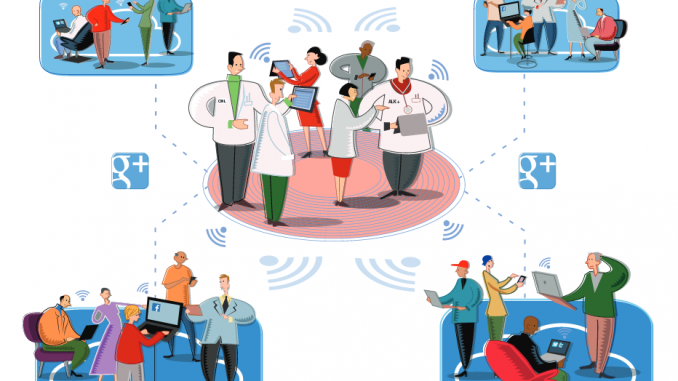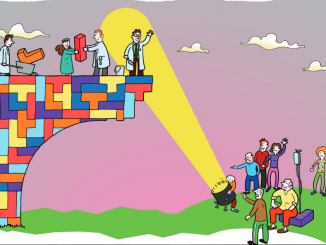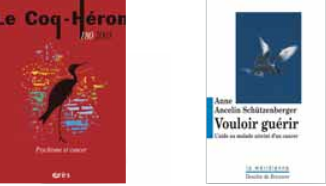
Online communities can help patients learn about and weigh up the options open to them. Where enough patients are involved, they are also helping to shape those options, opening up new opportunities for accelerating research and improving care.
This article was first published in The Oncologist vol. 18 no.7, and is republished with permission. © 2013 AlphaMed Press. doi:10.1634/theoncologist.2012-0453
Oncology is in the midst of transformation on several fronts. Anatomically defined diagnoses are being reclassified into molecularly defined subsets. A growing proportion of community-based oncologists are becoming employees of hospitals that are now increasingly becoming aligned into large networks covering broad geographic territories. The growing momentum of telemedicine is beginning to confer the possibility to deliver specialty and even subspecialty care to patients who would otherwise not have such ready access to it.
Along with these significant changes, access to information has been fundamentally altered by the Internet. For the first time, a significant proportion of patients and caregivers without formal medical training are turning to internet-based educational and support resources as they search online for relevant and reliable content.
Through these efforts, many patients are becoming engaged in learning about their treatment options, including clinical trial opportunities, from outside sources. As is the case with any profound change, there are potential beneficial and detrimental effects of the disruptive influence of online information and support on the relationship between patients and physicians, as well as on the conduct of clinical research in a new era of molecular oncology.
More information, more complexity
The volume of new content becoming available has been escalating rapidly – more than doubling over the past 20 years – to the point where it is infeasible for any single physician to remain updated on the emerging treatment options and clinical research opportunities across anything other than the most subspecialised patient population. This is particularly true in the field of oncology, for which there are currently over 200 medical journals focused on cancer[1].
This situation is coincident with a fundamental change in cancer care, which is transitioning from anatomically defined large and relatively heterogeneous groups (e.g. breast cancer, lung cancer and colon cancer) to molecularly defined narrow subgroups based on the presence of discrete driver mutations with identifiable targets. Therefore, there is a proliferation of targeted therapies that are largely characterised by their greater efficacy in these subgroups, although they often entail an additional challenge of requiring an ever-increasing battery of treatment-directing molecular tests. The pace of new discoveries in this field has been rapid and is limited by the lag time of typically at least one year – and sometimes three or more years – from initial discovery of relevant information and its publication[2], followed by additional time for its widespread dissemination within the oncologist community.
Taken together, we can see that there is a growing volume of new clinically relevant medical information, perhaps especially in oncology, which is experiencing a transformation to increasingly molecularly defined, limited subgroups. These dramatic changes have created new challenges in the ability of the practising oncologist to remain current on a rapidly proliferating array of treatment and research options.
More patients are seeking cancer information online
Concurrent with these changes in the field of oncology, more patients and caregivers are seeking very specific and current information from online sources. As we might expect, the proportion of American adults with internet access has been increasing, from 50% in 2000 to 85% in 2012[3]. Moreover, although many elderly adults are less likely to connect online, many of these patients have children who seek information online and therefore they have ‘second-degree’ access. Among patients with a chronic disease, people living with cancer are most likely to be directly engaged in their care[4], using the internet for both seeking information and for connection to other patients and caregivers for support through social media.
The quality of information available online varies; however, this is recognised by the lay public, who still consistently rank healthcare professionals as the most trusted source of medical information[6]. These findings corroborate those from the Health Information National Trends Survey by the National Cancer Institute, which concluded that trust in information from healthcare professionals had increased from 2002 to 2008, while trust in health information from the internet had waned7. Online content is commonly sought but also recognised as complementing rather than obviating good communication between patient and physician[7].
The online experience for patients typically entails more than collecting information. One of the critical elements of time spent online is the social connection afforded from fellow patients, caregivers, family, and friends – not only emotional support but also practical advice for managing daily challenges[9]. Accordingly, clinicians may see steadily rising numbers of patients participating in online communities, especially for rare diseases[10]. Beyond providing support and background information, these sources are increasingly becoming indirectly integrated into clinical practice from patients incorporating what they learn into their own decisions. Specifically, online communities are shaping management plans about where and from whom to receive treatment, when to pursue a second opinion, and whether to seek clinical trial options that may be unavailable and even unknown to their local medical team as treatment options become more specialised on the basis of narrower subgroups.
Online patient groups are changing medical practice and facilitating clinical research
With patients seeking information online, more are requesting specific treatment and tests that they may learn about from sources other than their own physician. Although physicians may have mixed feelings about patients seeking information about treatment options from outside sources that may not be relevant to the patient’s particular care, the fact remains that online groups have emerged as the “third party in the examination room” as a factor influencing patient perceptions of various management options[10]. Is this adding value or undermining patient care?
In a recent survey of over 2200 American adults by the Pew Internet Foundation, 42% of the overall population and 60% of ‘e-patients’ – the growing population of patients who are “equipped, enabled, empowered, and engaged in their health and health decisions”[7] – reported that they or someone they knew had been significantly helped by medical information they found online, compared with only 3% who reported that they or someone they knew had been harmed by online content[6]. Although not exhaustively studied, the limited available information does not support the contention that poor-quality information undermines the delivery of effective care.
Self-aggregating online patient groups have become instrumental in the transition into small, molecularly defined populations that are geographically distributed, essentially turning monolithic, large populations of anatomically defined cancers into subgroups that are akin to a new rare disease. These patients are increasingly sharing internet links to new research options and are facilitating faster enrolment in clinical trials seeking these rare populations, even leading patients to travel to the few locations in which very promising investigational agents are offered[11].
This beneficial effect of online communities emerged as early as a decade ago when the Life Raft Group, and several other international patient-based groups focused on advocacy and research efforts for gastrointestinal stromal tumours (GISTs), began sharing news of the growing favourable experiences with imatinib in clinical trials for patients with GISTs. This work led Dr George Demetri, one of the pivotal leaders in these nascent clinical research efforts in GISTs, to summarise, “The new research model pioneered by the Life Raft Group is making it possible for patients and family members to contribute to clinical research for their diseases in unprecedented ways”[5].
More recently, patients with lung cancer with the newly identified and very uncommon anaplastic lymphoma kinase (ALK) or ROS-1 rearrangements, for which the ALK inhibitor crizotinib has been demonstrated to be effective, have connected online to share information in discussion forums about a wide range of emerging investigational agents for this population, including LDK378, AP26113, CH5424802 and ganetespib[12]. This range of research options would exceed the knowledge base of not only a general oncologist but also nearly all specialists in thoracic oncology. On these discussion forums, patients from multiple different trial centres often share their experiences on early clinical trials in a way that enables patients to know more about the trends of outcomes in this early research than even the investigators, who are typically aware of only the results in the patients at their own treating facility.
These patients are increasingly sharing links to new research options and facilitating faster enrolment in clinical trials
A glimpse of the future and patient-initiated research
In addition to the potential for online communities to facilitate efforts of ongoing investigator-led trials in limited locations, there is a potential for patients to play a more active role in accelerating clinical research by facilitating research on their own clinical conditions, including pooling their data in aggregated databases that can be queried and potentially lead to new insights. Although generally limited by a heterogeneous quality of data entry and a far more open eligibility than the research enterprise led by established clinical researchers, these databases provide the potential to draw from a wide range of subjects and identify associations that may corroborate early clinical observations and/or generate new hypotheses that can be addressed in prospective trials.
Some online communities (PatientsLikeMe.com, CureTogether.com), are developing research efforts that offer the potential to aggregate findings of efficacy and tolerability of treatments for which there is little or no financial support for prospective clinical trials. With a growing emphasis on the validity of patient-reported outcomes (PROs) as relevant endpoints in clinical trials, these communities also provide a ready source of large numbers of subjects across a broad geography who are motivated to contribute to clinical research. Such communities can help overcome limitations of cost and reach large numbers of geographically dispersed patients for PROs in many research efforts. Nascent efforts in this direction have included the collection of self-assessed efficacy and toxicity, including peer-reviewed publication of these data[13,14].
CureTogether.com has recently partnered with 23andMe.com, a company that offers genome-wide screening analyses directly to consumers for a wide range of predictive markers for development of medical conditions in the future. Together, they are initiating a series of population-based studies of people diagnosed with specific medical conditions or identified predictive genetic factors. These companies are currently seeking to accrue up to 1000 patients with any form of sarcoma or myeloproliferative neoplasm to look for genetic markers in the patients; they potentially will expand to include evaluation of genetic markers in first- and second-degree relatives of patients.
Patients, physicians, and the online community
The Internet has disrupted many industries, with the delivery of healthcare now in the midst of an ongoing, rapid transformation. Among the leading factors in this process is the dramatic increase in the sheer volume of new medical content becoming available and the need to be integrated to formulate optimal treatment recommendations; this extent of new information precludes the possibility of any single healthcare professional knowing everything that could be helpful to a patient. Second, cancer care is evolving into a new era of molecularly defined subgroups that has created new complexity that requires greater individualisation of treatment recommendations, while often limiting appealing research opportunities to a few distant trial centres. Medical information is no longer available only to healthcare professionals, but rather it is often readily searchable by the lay public. Moreover, many patients are creating new content and sharing it in real time through online patient communities.
These patient communities are poised to help navigate these transitions. Self-aggregating narrow patient subgroups are facilitating communication about promising clinical trials for these populations. Many patients and caregivers are seeking to help their own cause by providing insights into their own experiences that can be aggregated into population-based data that may lead to a better understanding of their disease and potential novel treatment options. The clinical oncology community stands to benefit by capitalising on the potential of patients and caregivers to accelerate the research process and bridge the limitations of geography through the connectivity fostered by internet-based communities.
Author affiliation
Howard West is affiliated to the Swedish Cancer Institute, Global Resource for Advancing Cancer Education, Seattle, Washington, USA
References
1. Medical journals links: Oncology and cancer journals. [Accessed April 14, 2013]. Available at http://www.medical-journals-links.com/oncology-journals-cancer-journals.php
2. Pew Research Center. Pew internet trend data. [Accessed April 13, 2013]. Available at http://www.pewinternet.org/Trend-Data-(Adults)/Internet-Adoption.aspx
3. Center for Studying Health System Change. How engaged are consumers in their health and health care, and why does it matter. [Accessed April 13, 2013]. Available at http://www.hschange.com/CONTENT/1019/
4. Pew Research Center. The social life of health information. [Accessed April 13, 2013]. Available at http://www.pewinternet.org/Reports/2009/8-The-Social-Life-of-Health-Information.aspx
5. T Ferguson. e-Patients: How they can help us heal healthcare. [Accessed April 13, 2013]. Available at http://e-patients.net/e-Patients_White_Paper.pdf.
6. Cancer Network. Patients look for answers on web but trust it less. [Accessed April 13, 2013]. Available at http://www.cancernetwork.com/display/article/10165/1635865
7. S Fox. Cancer 2.0: A summary of recent research. [Accessed April 13, 2013]. Available at http://pewrsr.ch/Cancer20
8. X Hu X, RA Bell RA, RL Kravitz et al. (2011) The prepared patent: Information seeking of online support group members before their medical appointments. J Health Commun 17:960–978
9. S Fox. Peer to peer healthcare. [Accessed April 13, 2013]. Available at http://perinternetorg/Reports/2011/P2PHealthcare.aspx
10. B Vartabedian. Consumer health information: The new third party in the exam room. [Accessed April 13, 2013]. Available at http://getbetterhealth.com/consumer-health-information-the-new-third-party-in-the-exam-room/2011.02.13
11. HJ West, DR Camidge. (2012) Have mutation, will travel: Utilizing online patient communities and new trial strategies to optimize clinical research in a new era of molecularly diverse oncology. J Thorac Oncol 7:482–484
12. ALK or ROS1 NSCLC patient group. [Accessed November 23, 2012]. Available at http://cancergrace.org/topic/alk-or-ros1-nsclc-patient-group
13. J Call, NJ Scherzer, PD Josephy et al. (2010) Evaluation of self-reported progression and correlation of imatinib dose to survival in metastatic gastrointestinal stromal tumors: An open cohort study. J Gastrointest Cancer 41:60–70
14. P Wicks, TE Vaughan TE, MP Massigli MP et al. (2011) Accelerated clinical discovery using self-reported patient data collected online and a patient-matching algorithm. Nat Biotechnol 29:411–414





